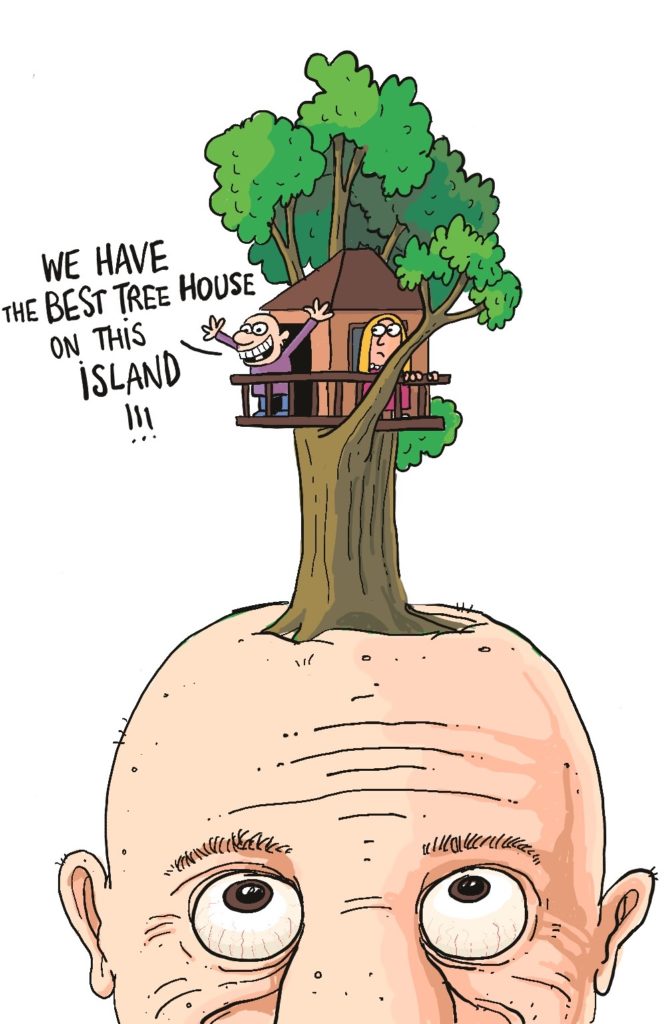This past week reminded me yet again of a common pattern in new ventures that is one of the most common killers of new ventures even if they get the 24 steps done well. It is what I call the “tree house mentality”.
I call it this because I remember when we were young and growing up, we would build tree houses—which generally were platforms in trees. They could be more elaborate with walls and open windows and maybe even a roof. You had to climb to get to them but once you got to them, you felt like you were in a world you controlled. It was super cool especially when you invited some friends… you felt like a king!
Well despite the fact that this is much more difficult to do today because of societal norms and pace, the metaphor has never left me.
In a tree house, in part because of the IKEA effect, you naturally felt like your tree house was in some ways superior to others. In a short period of time, it seemed like destiny that you were emotionally going to war with others in a different tree house because somehow you were superior. You would talk down about people in another tree house. People in your tree house would agree with each other and reinforce our opinions until those opinions became facts in our minds. It was so great and we felt so righteous.

The problem was when we came down from our tree house and dealt with others. Things were not as clear in others’ minds and they were not prone to be as quickly true believers. Even worse, there were other tree houses in which people were saying bad things about us and looking down on us. They thought we were inferior or evil in some type of unimaginable (to us) way. They would whip themselves into a near frenzy by from repeating unflattering things about us and our world view with no dialogue with us.
As I matured and thought more rationally (with some distance in time) about these possibly even well-meaning but ultimately nefarious situations, I saw the pattern. I came to see that much of what we were doing was the equivalent of “gossiping”.
The “tree house” mentality, whether tree houses were involved or not, was something that felt very good while doing it but I saw the end result was almost always not productive and certainly not inclusive. It was very destructive and hard to stop once it started.
Today, this modality dominates US politics. It is appropriately called “tribalism” by some. This is where the right-wing people watch Fox News. This group speaks badly about people not in their tribe, or proverbially “tree house”. Likewise, for the liberals, who watch MSNBC, it is the counter tree house. They talk about how incorrect the Fox News “facts” are and then how terrible people in the Fox News tribe are.
Confirmation bias and reinforcement of beliefs run rampant. Emotions get higher and positions become more intransigent. People on each side are unwilling to back down or even listen to another point of view.
I want to scream often, “Damn it, get out of your tree houses and come down and talk to each other!!! Find some common ground and build off it.”
Unfortunately, I see this tree house scenario happening in companies all the time and it kills them. It is perfectly understandable as we are all humans at the end of the day. We get frustrated and like to get a sympathetic sounding board for our grievances. Founders or executives are no different and they form some of the most emotional tribes. They start innocuously talking with others to see if their perspective is valid. Soon this grows until you have warring tribes. Intentions may or may not start out well-meaning but soon things escalate to a point of no return.
To be an entrepreneurial leader, you must know the threat of the “tree house” mentality, you must take steps to make sure it does not form and if it does, deal with it constructively and quickly.
Up to this point, I have described what this threat is and how destructive it can be. The steps to make sure it does not happen start at hiring, and then you have to be vigilant frequently thereafter. When I hire someone, I tell them that I will support them very strongly so s/he can do their job and advance their career … until such time as they start acting against the interests of the group. Then I will be their worst nightmare. The interests of the group are paramount.
Even so, grievances do arise and then they do, they must be dealt with in an open and constructive way. If someone on the team feels that something can be done to improve the collective team, then they have full support to raise the issue and it (and they) will be treated with respect in the process. It is important that they not just come forward with a grievance but also they should propose a solution to be discussed.
In fact, the team member who does this should be commended and rewarded for being creative in identifying opportunities for improvement and proposing (and hopefully implementing) new solutions. What will not be rewarded is simply complaining. Everyone must be productive. No whining. Secrecy is also not acceptable. Gossiping and political behavior is also rejected.
This can be hard for humans as this bad behavior comes naturally in social situations but as a leader, you must consistently and openly reject it in yourself and others. It can be uncomfortable at times as people are trying to be friendly to you or think they are providing you with important information but the job of a leader is not to be everyone’s friend. Your job is to be respected which is different. Recognizing tree house mentality, clear messaging that it is unacceptable from the start and then crushing it once it invariably shows it heads despite your best efforts – will generate the respect of the most valuable kind. If not, it will be a cancer that has a good chance to ultimately undermine all your other efforts so it is imperative to be a great entrepreneurial leader.
Get people out of their tree houses and come down to talk with each other and find common ground and constructive solutions.
The author
Bill Aulet
A longtime successful entrepreneur, Bill is the Managing Director of the Martin Trust Center for MIT Entrepreneurship and Professor of the Practice at the MIT Sloan School of Management. He is changing the way entrepreneurship is understood, taught, and practiced around the world.

The Disciplined Entrepreneurship Toolbox
Stay ahead by using the 24 steps together with your team, mentors, and investors.
The books
This methodology with 24 steps and 15 tactics was created at MIT to help you translate your technology or idea into innovative new products. The books were designed for first-time and repeat entrepreneurs so that they can build great ventures.

How relevant was this article to you?
Click on a star to rate it!
Average rating 5 / 5. Vote count: 1
No votes so far! Be the first to rate this post.
We are sorry that this article was not useful for you!
Let us improve this post!
Tell us how we can improve this post?

Love the illustration Marius!!!
This is a great post about a common failure. Another related symptom: the entrepreneur dreams up a complex business model that requires the customer and other parties in the ecosystem to change their behavior. Examples include royalties on a partner’s sales, and commissions through a sales channel that does not currently offer commissions. It all seems so logical to the entrepreneur, but requires too many other parties to buy into the dream.
Dave, completely correct. This is when people get their ideas disconnected from reality. Changing habits is one of the hardest things to do yet it is precisely what we as entrepreneurs are so often trying to do. This is why in my courses and workshops, I have the book “The Power of Habits” by Charles Duhigg (see http://bit.ly/2LrTJuW 9th book down) as an important read and reference for entrepreneurs. Ideas must be tested otherwise they are just concepts. Concepts are not reality. To become reality, they must be tested and validated to be true. The post I did since this one about the Netflix story is a classic example of this. Thanks for the insights Dave and keep them coming. Thanks also for the work you are doing with entrepreneurs in the silicon area. Entrepreneurship has to effect tough tech areas like that and not just the apps and software (although we love all entrepreneurship).
Yes I remember Duhigg calling this the “endowment effect”, i.e. our attachment to something into which we have invested time, effort and passion makes us blind to the shortcomings and limitations that are embedded within our initiative. Hence the importance of listening to other voices – without losing the essence of the vision. Of course, it’s easier to say than to carry out! I like how the tree house image makes it so tangible, and the metaphor of having to “come down” to speak with others.